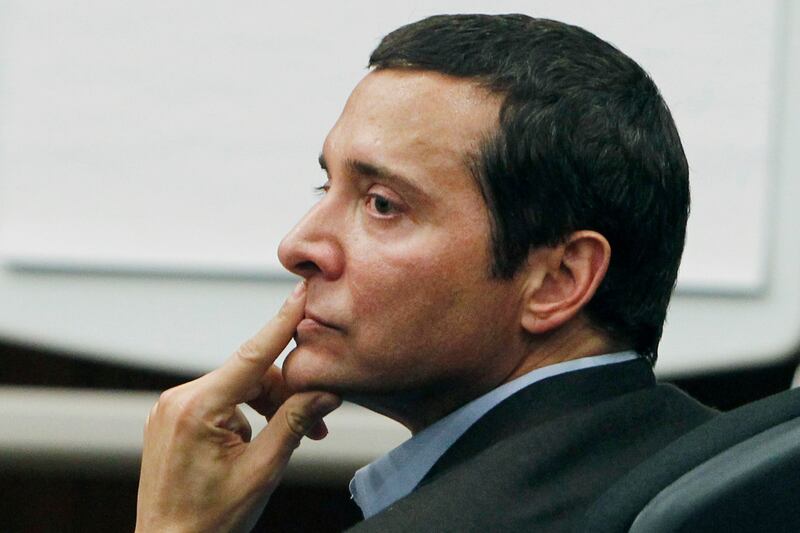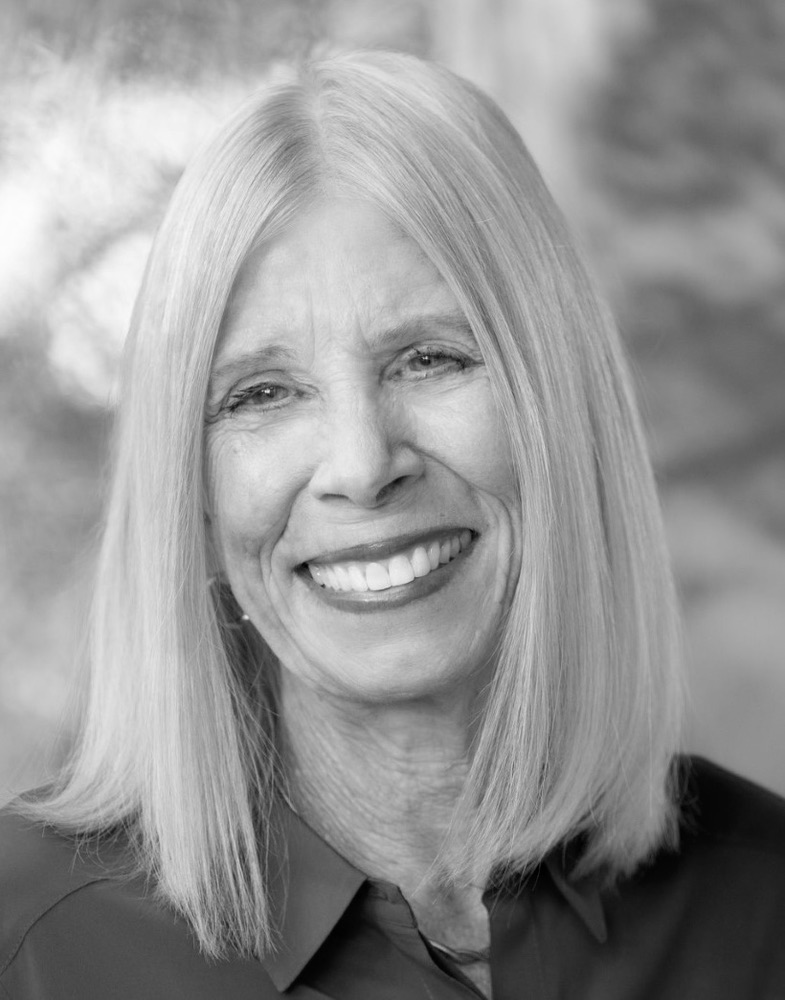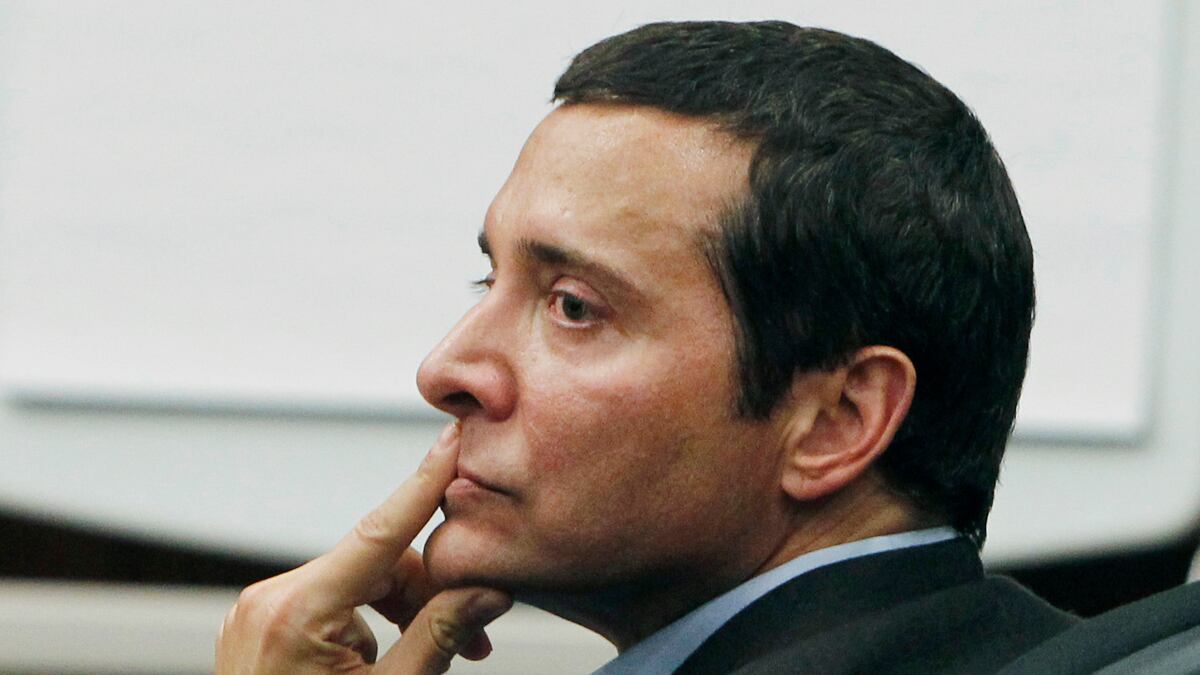James Arthur Ray, a once-prominent New Age motivational speaker, bestselling self-help author, and well-paid spiritual teacher who suggested clients could “create wealth in all areas” of their lives if they overcame hangups by shaving their heads, walking on hot coals, and bending rebar with their throats, was found guilty Wednesday of three counts of negligent homicide in connection with the deaths of three of people who attended a 2009 sweat-lodge event he ran near Sedona, Arizona.
Thirty-eight-year-old Kirby Brown, 40-year-old James Shore, and 49-year-old Liz Neuman died and several others were severely sickened after participating in the event, which capped Ray’s $10,000-a-head “Spiritual Warrior” retreat. The jury found Ray, 53, not guilty of the more serious offense of manslaughter. The swarthy, slender, tidily groomed ex-AT&T salesman from Oklahoma appeared calm as the verdicts were read. Jurors will reconvene in Yavapai County Superior Court in Campe Verde, Arizona, on June 28 for the “aggravation” phase of the trial, during which prosecutors will likely push for the maximum 11-year prison sentence.
During Ray’s five-day retreat in central Arizona’s Red Rock Country, clients who hoped to achieve “harmonic wealth” fasted in the desert and participated in a seven-hour “Samurai game,” during which some were forced to play dead on the floor until Ray (playing God) released them. The sweat lodge was the capstone experience of the retreat.
Prosecutors portrayed Ray, who declined to comment for this story, as a bully-guru who used mind control to prevent the victims from leaving the steamy tent, even though some participants cried out for help and others passed out from the extreme heat. What’s more, after the “ceremony” ended, prosecutors said, Ray left two dying victims in the tent while he cooled off for 15 minutes. Witnesses testified that clients in previous Ray sweat lodges also had become severely ill from the heat, driving home the prosecutor’s point that Ray should have known that the sweat lodge put his clients in danger.
“James Ray marketed himself as a qualified professional,” but his conduct “recklessly caused the deaths of participants,” Yavapai County prosecutor Sheila Polk told jurors.

Ray’s attorneys, Luis Li and Tom Kelly, countered that clients were not forced to stay in the sweat lodge and that some left the tent. They also said the more than 50 people who had crawled into the hot tent had signed waivers recognizing inherent dangers. Ray’s lawyers suggested organophosphates from pesticides inside the sweat lodge, not the heat, could have killed the victims. Because Ray rented the tent, he could not have known about the organophosphates, they said.
At the time of the deaths, sweat-lodge “experiences” were widely offered by tour guides, spa owners, and motivational speakers as lures for clients seeking a taste of Native American spirituality. But the Sedona incident prompted an apparent decline in the use of commercial sweat lodges, a trend that pleases many Native Americans, who believe sweat lodges are sacred and should not be commercialized. Now some see the Ray tragedy as karma.
In 2006, the International Spa Association promoted “sweat-lodge ceremonies” as a “one-of-a-kind experience.” The ISA defines sweat lodges as “an ancient Native American body-purification ceremony involving the use of intense heat similar to that of a sauna and other methods to provoke visions and insights,” ISA spokeswoman Shelby Jones said in an email.
And while Jones said the ISA does not track whether the popularity of spa sweat lodges has declined following the Sedona tragedy, anecdotal evidence suggests it has.
The New Age Health Spa in Neversink, New York, provided sweat-lodge experiences for “at least 15 or 20 years” as part of a larger “healthy living from the inside out” package, said general manager Lindy Goodman. The spa ran a sweat lodge about once a month, until news of the Sedona deaths broke. Now clients are not “as gung ho,” she said, and the spa has offered only one sweat-lodge experience this year.
Craig Knowles, owner of a company that offers tourists a “sweat-lodge experience” as part of a larger bison and wildlife adventure in Montana, said most of his clients are aware of “what happened in Arizona.” Many guests opt out, he says, even though his sweat lodge is not “very hot.”
Many Native Americans, including Ramon Riley, an Apache who credits sweat-lodge prayers for saving a holy mountain from a raging wildfire in Arizona, view the sweat-lodge ceremony as sacred.
Richard Moreno, a 43-year-old Pueblo-Tewa Indian and director of behavioral health for the Phoenix social service nonprofit Native American Connections, has participated in sweat-lodge ceremonies most of his life. Running a sweat lodge for money is a key “red flag” that the ceremony is fake, he said. And although white people are allowed in some native sweat lodges if the natives agree to it, he said, “having a non-native sweat leader is an oxymoron.”
Ray became an American self-help icon and bestselling author about five years ago, after appearing in the hit New Age documentary The Secret, which suggested that sending the right vibes into the universe attracts wealth, love, and health. It was a wildly popular message that drew criticism from mental-health professionals concerned that Americans would become angry and frustrated if their vibrations to the universe failed to attract harmony, health, and wealth.
Former Ray client Connie Joy turned her frustrations into a tell-all book. Joy, a San Diego real-estate agent, writes that from 2007 to 2009, she and her husband spent about $200,000 on seminars, events, and treks with Ray to Peru and Egypt. She portrays Ray as increasingly distant and arrogant.
Ex-Ray fans have followed the four-month trial closely. Some voiced frustration on social media because the Ray case got less publicity than the Casey Anthony murder trial. On Twitter, they cheered the prosecutor, Polk, and disparaged Ray.
Some former Ray clients remain cautiously loyal, however. Renette Christiansen, a 51-year-old California preschool teacher who says Ray “helped me change my life,” attended an earlier Ray Spiritual Warrior event. She says Ray “didn’t hold on to people and stop them” from leaving the sweat lodge.
“He was one of those high-adventure guys who wanted people to test their limits,” Christiansen said, “but he gave us the choice of opting out of experiences.”
Ray’s Facebook fan page continues to proffer New Age advice. “To be fully awake, fully human, and fully alive is to be continually thrown out of the nest. To embrace no-mans land,” a recent post says.
James Arthur Ray may soon have to take that advice to heart.





